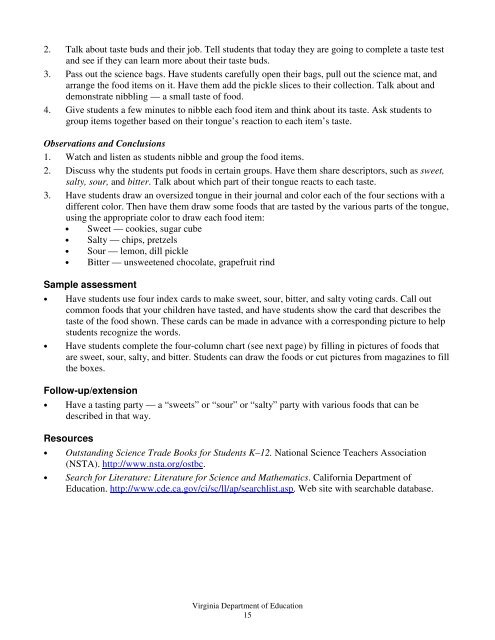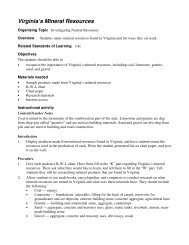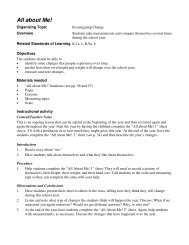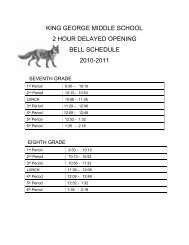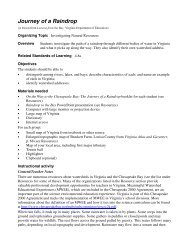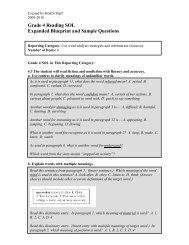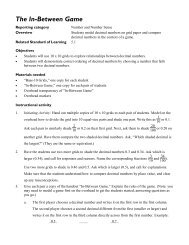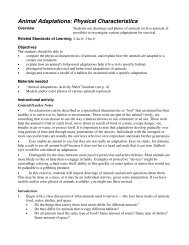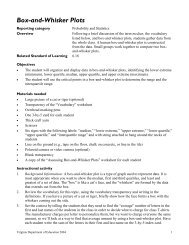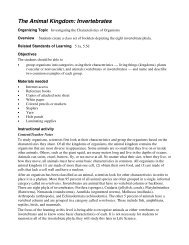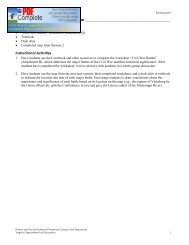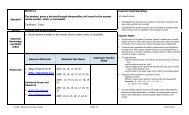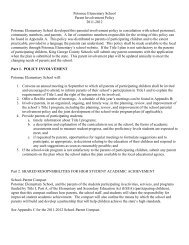Organizing Topic â Investigating the Five Senses
Organizing Topic â Investigating the Five Senses
Organizing Topic â Investigating the Five Senses
You also want an ePaper? Increase the reach of your titles
YUMPU automatically turns print PDFs into web optimized ePapers that Google loves.
2. Talk about taste buds and <strong>the</strong>ir job. Tell students that today <strong>the</strong>y are going to complete a taste test<br />
and see if <strong>the</strong>y can learn more about <strong>the</strong>ir taste buds.<br />
3. Pass out <strong>the</strong> science bags. Have students carefully open <strong>the</strong>ir bags, pull out <strong>the</strong> science mat, and<br />
arrange <strong>the</strong> food items on it. Have <strong>the</strong>m add <strong>the</strong> pickle slices to <strong>the</strong>ir collection. Talk about and<br />
demonstrate nibbling — a small taste of food.<br />
4. Give students a few minutes to nibble each food item and think about its taste. Ask students to<br />
group items toge<strong>the</strong>r based on <strong>the</strong>ir tongue’s reaction to each item’s taste.<br />
Observations and Conclusions<br />
1. Watch and listen as students nibble and group <strong>the</strong> food items.<br />
2. Discuss why <strong>the</strong> students put foods in certain groups. Have <strong>the</strong>m share descriptors, such as sweet,<br />
salty, sour, and bitter. Talk about which part of <strong>the</strong>ir tongue reacts to each taste.<br />
3. Have students draw an oversized tongue in <strong>the</strong>ir journal and color each of <strong>the</strong> four sections with a<br />
different color. Then have <strong>the</strong>m draw some foods that are tasted by <strong>the</strong> various parts of <strong>the</strong> tongue,<br />
using <strong>the</strong> appropriate color to draw each food item:<br />
• Sweet — cookies, sugar cube<br />
• Salty — chips, pretzels<br />
• Sour — lemon, dill pickle<br />
• Bitter — unsweetened chocolate, grapefruit rind<br />
Sample assessment<br />
• Have students use four index cards to make sweet, sour, bitter, and salty voting cards. Call out<br />
common foods that your children have tasted, and have students show <strong>the</strong> card that describes <strong>the</strong><br />
taste of <strong>the</strong> food shown. These cards can be made in advance with a corresponding picture to help<br />
students recognize <strong>the</strong> words.<br />
• Have students complete <strong>the</strong> four-column chart (see next page) by filling in pictures of foods that<br />
are sweet, sour, salty, and bitter. Students can draw <strong>the</strong> foods or cut pictures from magazines to fill<br />
<strong>the</strong> boxes.<br />
Follow-up/extension<br />
• Have a tasting party — a “sweets” or “sour” or “salty” party with various foods that can be<br />
described in that way.<br />
Resources<br />
• Outstanding Science Trade Books for Students K–12. National Science Teachers Association<br />
(NSTA). http://www.nsta.org/ostbc.<br />
• Search for Literature: Literature for Science and Ma<strong>the</strong>matics. California Department of<br />
Education. http://www.cde.ca.gov/ci/sc/ll/ap/searchlist.asp. Web site with searchable database.<br />
Virginia Department of Education<br />
15


